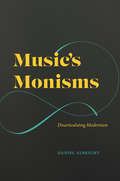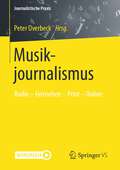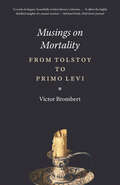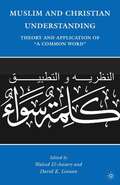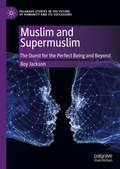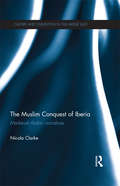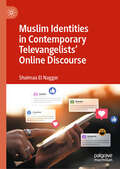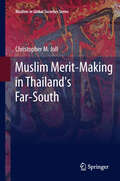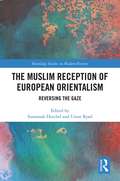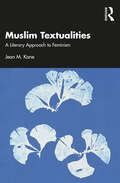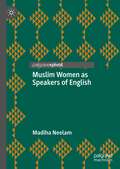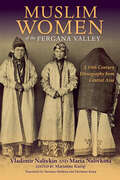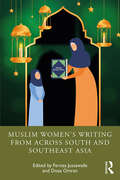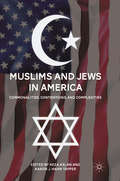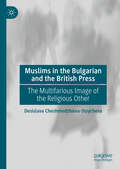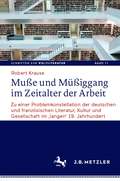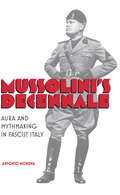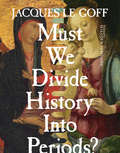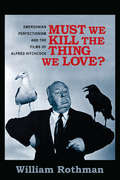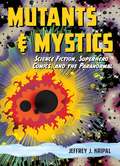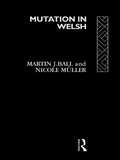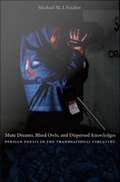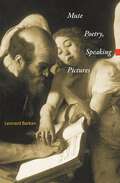- Table View
- List View
Music's Monisms: Disarticulating Modernism
by Daniel AlbrightDaniel Albright investigates musical phenomena through the lens of monism, the philosophical belief that things that appear to be two are actually one. Daniel Albright was one of the preeminent scholars of musical and literary modernism, leaving behind a rich body of work before his untimely passing. In Music’s Monisms, he shows how musical and literary phenomena alike can be fruitfully investigated through the lens of monism, a philosophical conviction that does away with the binary structures we use to make sense of reality. Albright shows that despite music’s many binaries—diatonic vs. chromatic, major vs. minor, tonal vs. atonal—there is always a larger system at work that aims to reconcile tension and resolve conflict. Albright identifies a “radical monism” in the work of modernist poets such as T. S. Eliot and musical works by Wagner, Debussy, Britten, Schoenberg, and Stravinsky. Radical monism insists on the interchangeability, even the sameness, of the basic dichotomies that govern our thinking and modes of organizing the universe. Through a series of close readings of musical and literary works, Albright advances powerful philosophical arguments that not only shed light on these specific figures but also on aesthetic experience in general. Music’s Monisms is a revelatory work by one of modernist studies’ most distinguished figures.
Musikjournalismus: Radio – Fernsehen – Print – Online (Journalistische Praxis)
by Peter OverbeckDieses Buch vermittelt die Grundlagen des Musikjournalismus. Erfahrene Praktiker informieren über die verschiedenen journalistischen Tätigkeiten – von der Programmgestaltung über die Musikkritik bis zur Moderation von Musiksendungen und Interviews mit Musikern in den Musiksparten von Klassik bis Pop. Die Besonderheiten in Radio, Fernsehen, Print und Online werden anhand zahlreicher Beispiele analysiert, die Funktion und der Einsatz von Musik sowie sprachliche, dramaturgische und gestalterische Mittel erörtert. Es gibt Tipps zum Berufsbild und zur Ausbildung und zu den vielfältigen Tätigkeiten.
Musings on Mortality: From Tolstoy to Primo Levi
by Victor Brombert“Elegant, beautifully written literary criticism, examining how eight major writers—‘From Tolstoy to Primo Levi’—dealt with death in their fiction.” —The Wall Street Journal“All art and the love of art,” Victor Brombert writes at the beginning of the deeply personal Musings on Mortality, “allow us to negate our nothingness.” As a young man returning from World War II, Brombert came to understand this truth as he immersed himself in literature. Death can be found everywhere in literature, he saw, but literature itself is on the side of life. With delicacy and penetrating insight, Brombert traces the theme of mortality in the work of a group of modern writers: Leo Tolstoy, Thomas Mann, Franz Kafka, Virginia Woolf, Albert Camus, Giorgio Bassani, J. M. Coetzee, and Primo Levi. Illuminating their views on the meaning of life and the human condition, Brombert ultimately, reveals that by understanding how these authors wrote about mortality, we can grasp the full scope of their literary achievement and vision.Winner of the Robert Penn Warren-Cleanth Brooks award for outstanding literary criticism.“Suffused with wisdom and argued with the strong hand of a weathered and feeling literary scholar. . . . It is hard to imagine such thematic criticism being done better than here. What a beautiful book.” —Thomas Harrison, author of 1910: The Emancipation of Dissonance“A brave and eloquent book.” — Peter Brooks, author of Henry James Goes to Paris“The simplicity and directness of Brombert’s style gives his discussion of the philosophical and aesthetic underpinnings of the works under scrutiny great clarity.” —Publishers Weekly“Brombert’s eloquently written book is for serious lovers of literature.” —Library Journal
Muslim and Christian Understanding
by Waleed El-Ansary David K. LinnanThis book explores 'A Common Word Between Us and You', a high-level ongoing Christian-Muslim dialogue process. The Common Word process was commenced by leading Islamic scholars and intellectuals as outreach in response to the Pope's much criticized Regensburg address of 2007.
Muslim and Supermuslim: The Quest for the Perfect Being and Beyond (Palgrave Studies in the Future of Humanity and its Successors)
by Roy JacksonThis book looks to the rich and varied Islamic tradition for insights into what it means to be human and, by implication, what this can tell us about the future human. The transhumanist movement, in its more radical expression, sees Homo sapiens as the cousin, perhaps the poorer cousin, of a new Humanity 2.0: ‘Man’ is replaced by ‘Superman’. The contribution that Islam can make to this movement concerns the central question of what this ‘Superman’ – or ‘Supermuslim’ – would actually entail. To look at what Islam can contribute we need not restrict ourselves to the Qur’an and the legal tradition, but also reach out to its philosophical and literary corpus. Roy Jackson focuses on such contributions from Muslim philosophy, science, and literature to see how Islam can confront and respond to the challenges raised by the growing movement of transhumanism.
The Muslim Conquest of Iberia: Medieval Arabic Narratives (Culture and Civilization in the Middle East)
by Nicola ClarkeMedieval Islamic society set great store by the transmission of history: to edify, argue legal points, explain present conditions, offer political and religious legitimacy, and entertain. Modern scholars, too, have had much to say about the usefulness of early Islamic history-writing, although this debate has traditionally focused overwhelmingly on the central Islamic lands. This book looks instead at local and regional history-writing in Medieval Iberia. Drawing on numerous Arabic texts – historical, geographical and biographical – composed and transmitted in al-Andalus, North Africa and the Islamic east between the ninth and fourteenth centuries, Nicola Clarke offers a nuanced and detailed analysis of narratives about the eighth-century Muslim conquest of Iberia. Comparing how individual episodes, characters, and themes are treated in different texts, and how this treatment relates to intellectual debates, literary trends, and socio-political conditions at the time of writing, she shows how competing priorities shaped myriad variations on a single story and how the scholars and patrons of a corner of the Islamic world distant from Baghdad viewed their own history. Offering a framework in which historians of Christian Iberia (and of Christian Europe more generally) can approach and make sense of culturally-significant texts from Muslim Iberia, this book will also be relevant to broader debates about the historiography of early Islam. As such, it will be of great interest to scholars of historiography, world history and Islamic studies.
Muslim Identities in Contemporary Televangelists' Online Discourse
by Shaimaa El NaggarThis book examines the discourse of Muslim televangelism in the West, particularly looking at the emergence of 'home-grown' televangelists who grew up in the West and deliver their sermons in English, addressing audiences in contexts such as the UK and the USA. In their sermons, televangelists address topics that are relevant to the everyday life of Muslims and Muslim youth such as friendship, marriage and the misrepresentation of Islam/Muslims in mass media. This book explores contemporary Muslim televangelism and its manifestations in other forms of digital religion, including YouTube, websites and social media which mediate religious content. Using a Critical Discourse Studies approach, the author explores the power structures underpinning the popularity of Muslim televangelism, investigates the linguistic strategies used by Muslim televangelists to construct their identities online, and analyses how Islam and Muslims are represented in their sermons. This book will be of interest to religious studies, media studies, and discourse studies scholars, and to anyone interested in the topic of Islam/Muslims in the West in the contemporary age.
Muslim Merit-making in Thailand's Far-South
by Christopher M. JollThis volume provides an ethnographic description of Muslim merit-making rhetoric, rituals and rationales in Thailand's Malay far-south. This study is situated in Cabetigo, one of Pattani's oldest and most important Malay communities that has been subjected to a range of Thai and Islamic influences over the last hundred years. The volume describes religious rhetoric related to merit-making being conducted in both Thai and Malay, that the spiritual currency of merit is generated through the performance of locally occurring Malay adat, and globally normative amal 'ibadat. Concerning the rationale for merit-making, merit-makers are motivated by both a desire to ensure their own comfort in the grave and personal vindication at judgment, as well as to transfer merit for those already in the grave, who are known to the merit-maker. While the rhetoric elements of Muslim merit-making reveal Thai influence, its ritual elements confirm the local impact of reformist activism.
The Muslim Reception of European Orientalism: Reversing the Gaze (Routledge Studies in Modern History)
by Susannah Heschel Umar RyadEdward Said’s Orientalism, now more than fifty years old, has to be one of the most frequently cited books among academics in a wide range of disciplines, and the most frequently assigned book to undergraduates at colleges. Among the common questions raised in response to Said’s book: Did scholars in Western Europe provide crucial support to the imperialist, colonialist activities of European regimes? Are their writings on Islam laden with denigrating, eroticized, distorting biases that have left an indelible impact on Western society? What is the "Orientalism" invented by Europe and what is its impact today? However, one question has been less raised (or less has been done about the question): How were the Orientalist writings of European scholars of Islam received among their Muslim contemporaries? An international team of contributors rectify this oversight in this volume.
Muslim Textualities: A Literary Approach to Feminism
by Jean M. KaneIn the first decade of the twenty-first century, Muslim women writers located in Europe and American entered the cultural mainstream. Literary and visual productions negotiated static visual emblems of Islam, most prominently "the veil." They did so not by rejecting veiling practices, but by adapting Muslim resources, concepts and visual tradition to empowerment narratives in popular media. Mainstream reception of their works has often overlooked or misread these negotiations. Muslim Textualities argues for more flexible and capacious interpretation, with particular attention to visibility as a metaphor for political agency and to knowledge of cultural contexts. This provocative volume aims to articulate Muslim female agency through clear and accessible analysis of the theory and concepts driving the interpretation of these works. Scholars interested in the working representations of Muslim women, feminist subjectivities, and the complexities of gender roles, patriarchy, and feminism will find this volume of particular interest.
Muslim Women as Speakers of English
by Madiha NeelamThis book examines representations of Muslim women as speakers of English in the context of a language ideological debate in the UK in 2016. The author shows how Muslim women are stereotyped as non-speakers of English through the manipulation of census data, and how this supposed lack of English is discursively constructed as an index of their supposed oppression, complicity in the threat of extremism emanating from their sons, and limited participation in the labour force. The book aims to complement a growing body of research on raciolinguistics and language ideologies. It illuminates the intersection of language, Islamophobia, and securitization, and will be of interest to postgraduate students and academics working in applied linguistics and discourse analysis, and interdisciplinary audiences in studies of race, Islamophobia, and gender.
Muslim Women of the Fergana Valley: A 19th-Century Ethnography from Central Asia
by Mariana Markova Maria Nalivkina Marianne Kamp Vladimir NalivkinMuslim Women of the Fergana Valley is the first English translation of an important 19th-century Russian text describing everyday life in Uzbek communities. Vladimir and Maria Nalivkin were Russians who settled in a "Sart" village in 1878, in a territory newly conquered by the Russian Empire. During their six years in Nanay, Maria Nalivkina learned the local language, befriended her neighbors, and wrote observations about their lives from birth to death. Together, Maria and Vladimir published this account, which met with great acclaim from Russia's Imperial Geographic Society and among Orientalists internationally. While they recognized that Islam shaped social attitudes, the Nalivkins never relied on common stereotypes about the "plight" of Muslim women. The Fergana Valley women of their ethnographic portrait emerge as lively, hard-working, clever, and able to navigate the cultural challenges of early Russian colonialism. Rich with social and cultural detail of a sort not available in other kinds of historical sources, this work offers rare insight into life in rural Central Asia and serves as an instructive example of the genre of ethnographic writing that was emerging at the time. Annotations by the translators and an editor's introduction by Marianne Kamp help contemporary readers understand the Nalivkins' work in context.
Muslim Women’s Writing from across South and Southeast Asia
by Feroza JussawallaThis essential collection examines South and Southeast Asian Muslim women’s writing and the ways they navigate cultural, political, and controversial boundaries. Providing a global, contemporary collection of essays, this volume uses varied methods of analysis and methodology, including: • Contemporary forms of expression, such as memoir, oral accounts, romance novels, poetry, and social media; • Inclusion of both recognized and lesser-known Muslim authors; • Division by theme to shed light on geographical and transnational concerns; and • Regional focus on Afghanistan, Pakistan, India, Bangladesh, Sri Lanka, Malaysia, and Indonesia. Muslim Women’s Writing from across South and Southeast Asia will deliver crucial scholarship for all readers interested in the varied perspectives and comparisons of Southern Asian writing, enabling both students and scholars alike to become better acquainted with the burgeoning field of Muslim women's writing. This timely and challenging volume aims to give voice to the creative women who are frequently overlooked and unheard.
Muslims and Jews in America
by Reza Aslan Aaron J. Hahn TapperThis book is an exploration of contemporary Jewish-Muslim relations in the United States and the distinct ways in which these two communities interact with one another in the American context. Each essay discusses a different episode from the recent twentieth and current twenty-first century American milieu that links these two groups together.
Muslims in the Bulgarian and the British Press: The Multifarious Image of the Religious Other
by Desislava Cheshmedzhieva-StoychevaThis book compares the ways in which the national media in two different countries construct (frame) and develop the image of the religious other, in this case Muslims in all their variety. Although it introduces concepts such as race and racism, otherness, Orientalism and Islamophobia, which may be familiar to the majority of readers, in this manuscript they serve the purpose of a comparative analysis which has not been done on the subject to date. The manuscript analyzes the thematic distribution of the articles, as well as the definitions, metaphors and stereotypes used, thus presenting a complete and diverse image of Muslims along with the similarities and differences in the thinking patterns employed by Bulgarians and British on the subject and expressed in the respective mainstream media. In this respect the manuscript fills a void in the scholarly literature on the ways the media discourses in two very different countries present the image of a religious group. Here we can even talk about the existing divide between East and West and the changing perception of the religious Other fostered by the general digitalization and free flow of information. As English is an international language it undeniably makes access to information easier, however, there are not many culture specific studies presenting the current state of a problem or the analyses on that particular topic (the image of Muslims) in that international medium. Therefore, the manuscript aims at introducing English speaking scholars, students, media people, and generally everyone interested in the topic, to the Bulgarian way of seeing, depicting and talking about Muslims. As stated above, the manuscript draws parallels between the language used by the Bulgarian and the British media, thus providing a similar starting point as the majority of the potential readers are probably more familiar with the latter. In addition, scholars working extensively with other local cultures and/or media and resorting to English as a medium for the popularization of their research, can use the presented analytical frame to their specific analyses and contribute even further to the enrichment of the global data base on the topic.
Muße und Müßiggang im Zeitalter der Arbeit: Zu einer Problemkonstellation der deutschen und französischen Literatur, Kultur und Gesellschaft im ‚langen‘ 19. Jahrhundert (Schriften zur Weltliteratur/Studies on World Literature #11)
by Robert KrauseDie Geschichte der Moderne wurde oft als eine Geschichte der modernen Arbeitswelt – im Sinne der Ausdifferenzierung, Ökonomisierung, Professionalisierung und Beschleunigung – erzählt. Sie ist aber auch eine Geschichte neuer Formen der ‚Muße‘ und des ‚Müßiggangs‘, die ebenso einen Teil dessen bilden, was wir heute ‚modern‘ nennen. Mit dem spannungsreichen Verhältnis von Arbeit, Muße und Müßiggang in der Moderne beschäftigt sich die vorliegende komparatistische Studie; sie bietet Einblicke in Konzepte, Diskurse und Figurationen der Muße und des Müßiggangs in der modernen deutschen und französischen Literatur, Kultur und Philosophie und unterzieht den schillernden Begriff der Moderne selbst einer fundamentalen Revision.
Mussolini's Decennale
by Antonio MorenaThe year 1932, the tenth anniversary of Mussolini's March on Rome, was fascism's Decennale. Commemorating Italian fascism's seizure of power, the Decennale was celebrated by the regime in a deliberate attempt to radicalize the original movement and develop it into an imperial and racist regime.In Mussolini's Decennale, Antonio Morena explores a cross-section of Italian culture during the Decennale. Studying literature, speeches, documentaries, films, textbooks, and the 1932 Exhibition, he discusses how the regime, its patrons, and even its critics all appropriated the historical events of 1922 for their political advantage. Positioning the 1932 anniversary celebrations as the crux of the fascist transition from conservatism to totalitarianism, Mussolini's Decennale broadens our understanding of fascist ideology, cultural politics, and Realpolitik.
Must We Divide History Into Periods? (European Perspectives: A Series in Social Thought and Cultural Criticism)
by Jacques Le GoffWe have long thought of the Renaissance as a luminous era that marked a decisive break with the past, but the idea of the Renaissance as a distinct period arose only during the nineteenth century. Though the view of the Middle Ages as a dark age of unreason has softened somewhat, we still locate the advent of modern rationality in the Italian thought and culture of the fifteenth and sixteenth centuries. Jacques Le Goff pleads for a strikingly different view. In this, his last book, he argues persuasively that many of the innovations we associate with the Renaissance have medieval roots, and that many of the most deplorable aspects of medieval society continued to flourish during the Renaissance. We should instead view Western civilization as undergoing several "renaissances" following the fall of Rome, over the course of a long Middle Ages that lasted until the mid-eighteenth century. While it is indeed necessary to divide history into periods, Le Goff maintains, the meaningful continuities of human development only become clear when historians adopt a long perspective. Genuine revolutions—the shifts that signal the end of one period and the beginning of the next—are much rarer than we think.
Must We Kill the Thing We Love?: Emersonian Perfectionism and the Films of Alfred Hitchcock (Film and Culture Series)
by William RothmanWilliam Rothman argues that the driving force of Hitchcock's work was his struggle to reconcile the dark vision of his favorite Oscar Wilde quote, "Each man kills the thing he loves," with the quintessentially American philosophy, articulated in Emerson's writings, that gave classical Hollywood movies of the New Deal era their extraordinary combination of popularity and artistic seriousness. A Hitchcock thriller could be a comedy of remarriage or a melodrama of an unknown woman, both Emersonian genres, except for the murderous villain and godlike author, Hitchcock, who pulls the villain's strings—and ours. Because Hitchcock believed that the camera has a murderous aspect, the question "What if anything justifies killing?," which every Hitchcock film engages, was for him a disturbing question about his own art. Tracing the trajectory of Hitchcock's career, Rothman discerns a progression in the films' meditations on murder and artistic creation. This progression culminates in Marnie (1964), Hitchcock's most controversial film, in which Hitchcock overcame his ambivalence and fully embraced the Emersonian worldview he had always also resisted.Reading key Emerson passages with the degree of attention he accords to Hitchcock sequences, Rothman discovers surprising affinities between Hitchcock's way of thinking cinematically and the philosophical way of thinking Emerson's essays exemplify. He finds that the terms in which Emerson thought about reality, about our "flux of moods," about what it is within us that never changes, about freedom, about America, about reading, about writing, and about thinking are remarkably pertinent to our experience of films and to thinking and writing about them. He also reflects on the implications of this discovery, not only for Hitchcock scholarship but also for film criticism in general.
Mutant Neoliberalism: Market Rule and Political Rupture
by William Callison and Zachary ManfrediTales of neoliberalism’s death are serially overstated. Following the financial crisis of 2008, neoliberalism was proclaimed a “zombie,” a disgraced ideology that staggered on like an undead monster. After the political ruptures of 2016, commentators were quick to announce “the end” of neoliberalism yet again, pointing to both the global rise of far-right forces and the reinvigoration of democratic socialist politics. But do new political forces sound neoliberalism’s death knell or will they instead catalyze new mutations in its dynamic development?Mutant Neoliberalism brings together leading scholars of neoliberalism—political theorists, historians, philosophers, anthropologists and sociologists—to rethink transformations in market rule and their relation to ongoing political ruptures. The chapters show how years of neoliberal governance, policy, and depoliticization created the conditions for thriving reactionary forces, while also reflecting on whether recent trends will challenge, reconfigure, or extend neoliberalism’s reach. The contributors reconsider neoliberalism’s relationship with its assumed adversaries and map mutations in financialized capitalism and governance across time and space—from Europe and the United States to China and India. Taken together, the volume recasts the stakes of contemporary debate and reorients critique and resistance within a rapidly changing landscape.Contributors: Étienne Balibar, Sören Brandes, Wendy Brown, Melinda Cooper, Julia Elyachar, Michel Feher, Megan Moodie, Christopher Newfield, Dieter Plehwe, Lisa Rofel, Leslie Salzinger, Quinn Slobodian
Mutants and Mystics: Science Fiction, Superhero Comics, and the Paranormal
by Jeffrey J. KripalIn many ways, twentieth-century America was the land of superheroes and science fiction. From Superman and Batman to the Fantastic Four and the X-Men, these pop-culture juggernauts, with their "powers and abilities far beyond those of mortal men," thrilled readers and audiences--and simultaneously embodied a host of our dreams and fears about modern life and the onrushing future. But that's just scratching the surface, says Jeffrey Kripal. In Mutants and Mystics, Kripal offers a brilliantly insightful account of how comic book heroes have helped their creators and fans alike explore and express a wealth of paranormal experiences ignored by mainstream science. Delving deeply into the work of major figures in the field--from Jack Kirby's cosmic superhero sagas and Philip K. Dick's futuristic head-trips to Alan Moore's sex magic and Whitley Strieber's communion with visitors--Kripal shows how creators turned to science fiction to convey the reality of the inexplicable and the paranormal they experienced in their lives. Expanded consciousness found its language in the metaphors of sci-fi--incredible powers, unprecedented mutations, time-loops and vast intergalactic intelligences--and the deeper influences of mythology and religion that these in turn drew from; the wildly creative work that followed caught the imaginations of millions. Moving deftly from Cold War science and Fredric Wertham's anticomics crusade to gnostic revelation and alien abduction, Kripal spins out a hidden history of American culture, rich with mythical themes and shot through with an awareness that there are other realities far beyond our everyday understanding. A bravura performance, beautifully illustrated in full color throughout and brimming over with incredible personal stories, Mutants and Mystics is that rarest of things: a book that is guaranteed to broaden--and maybe even blow--your mind.
Mutants & Mystics: Science Fiction, Superhero Comics, and the Paranormal
by Jeffrey J. KripalIn many ways, twentieth-century America was the land of superheroes and science fiction. From Superman and Batman to the Fantastic Four and the X-Men, these pop-culture juggernauts, with their "powers and abilities far beyond those of mortal men," thrilled readers and audiences—and simultaneously embodied a host of our dreams and fears about modern life and the onrushing future. But that's just scratching the surface, says Jeffrey Kripal. In Mutants and Mystics, Kripal offers a brilliantly insightful account of how comic book heroes have helped their creators and fans alike explore and express a wealth of paranormal experiences ignored by mainstream science. Delving deeply into the work of major figures in the field—from Jack Kirby’s cosmic superhero sagas and Philip K. Dick’s futuristic head-trips to Alan Moore’s sex magic and Whitley Strieber’s communion with visitors—Kripal shows how creators turned to science fiction to convey the reality of the inexplicable and the paranormal they experienced in their lives. Expanded consciousness found its language in the metaphors of sci-fi—incredible powers, unprecedented mutations, time-loops and vast intergalactic intelligences—and the deeper influences of mythology and religion that these in turn drew from; the wildly creative work that followed caught the imaginations of millions. Moving deftly from Cold War science and Fredric Wertham's anticomics crusade to gnostic revelation and alien abduction, Kripal spins out a hidden history of American culture, rich with mythical themes and shot through with an awareness that there are other realities far beyond our everyday understanding. A bravura performance, beautifully illustrated in full color throughout and brimming over with incredible personal stories, Mutants and Mystics is that rarest of things: a book that is guaranteed to broaden—and maybe even blow—your mind.
Mutation in Welsh
by Martin J. Ball Nicole MüllerFirst published in 2002. Routledge is an imprint of Taylor & Francis, an informa company.
Mute Dreams, Blind Owls, and Dispersed Knowledges: Persian Poesis in the Transnational Circuitry
by Michael M. J. FischerOver the past decade Iranian films have received enormous international attention, garnering both critical praise and popular success. Combining his extensive ethnographic experience in Iran and his broad command of critical theory, Michael M. J. Fischer argues that the widespread appeal of Iranian cinema is based in a poetics that speaks not only to Iran's domestic cultural politics but also to the more general ethical dilemmas of a world simultaneously torn apart and pushed together. Approaching film as a tool for anthropological analysis, he illuminates how Iranian filmmakers have incorporated and remade the rich traditions of oral, literary, and visual media in Persian culture. Fischer reveals how the distinctive expressive idiom emerging in contemporary Iranian film reworks Persian imagery that has itself been in dialogue with other cultures since the time of Zoroaster and ancient Greece. He examines a range of narrative influences on this expressive idiom and imagery, including Zoroastrian ritual as it is practiced in Iran, North America, and India; the mythic stories, moral lessons, and historical figures written about in Iran's national epic, the Shahnameh; the dreamlike allegorical world of Persian surrealism exemplified in Sadeq Hedayat's 1939 novella The Blind Owl; and the politically charged films of the 1960s and 1970s. Fischer contends that by combining Persian traditions with cosmopolitan influences, contemporary Iranian filmmakers--many of whom studied in Europe and America--provide audiences around the world with new modes of accessing ethical and political experiences.
Mute Poetry, Speaking Pictures (Essays in the Arts)
by Leonard BarkanThe skirmish between painting and poetry—from Plato and Praxiteles to Rembrandt and ShakespeareWhy do painters sometimes wish they were poets—and why do poets sometimes wish they were painters? What happens when Rembrandt spells out Hebrew in the sky or Poussin spells out Latin on a tombstone? What happens when Virgil, Ovid, or Shakespeare suspend their plots to describe a fictitious painting? In Mute Poetry, Speaking Pictures, Leonard Barkan explores such questions as he examines the deliciously ambiguous history of the relationship between words and pictures, focusing on the period from antiquity to the Renaissance but offering insights that also have much to say about modern art and literature.The idea that a poem is like a picture has been a commonplace since at least ancient Greece, and writers and artists have frequently discussed poetry by discussing painting, and vice versa, but their efforts raise more questions than they answer. From Plutarch ("painting is mute poetry, poetry a speaking picture") to Horace ("as a picture, so a poem"), apparent clarity quickly leads to confusion about, for example, what qualities of pictures are being urged upon poets or how pictorial properties can be converted into poetical ones.The history of comparing and contrasting painting and poetry turns out to be partly a story of attempts to promote one medium at the expense of the other. At the same time, analogies between word and image have enabled writers and painters to think about and practice their craft. Ultimately, Barkan argues, this dialogue is an expression of desire: the painter longs for the rich signification of language while the poet yearns for the direct sensuousness of painting.
